[English] 日本語
 Yorodumi
Yorodumi- PDB-4dwf: Crystal structure of a HLA-B associated transcript 3 (BAT3) from ... -
+ Open data
Open data
- Basic information
Basic information
| Entry | Database: PDB / ID: 4dwf | ||||||
|---|---|---|---|---|---|---|---|
| Title | Crystal structure of a HLA-B associated transcript 3 (BAT3) from Homo sapiens at 1.80 A resolution | ||||||
 Components Components | HLA-B-associated transcript 3 | ||||||
 Keywords Keywords |  STRUCTURAL GENOMICS / UNKNOWN FUNCTION / STRUCTURAL GENOMICS / UNKNOWN FUNCTION /  Ubiquitin-like domain / Ubiquitin-like domain /  BAT3 protein / PF00240 / Joint Center for Structural Genomics / JCSG / BAT3 protein / PF00240 / Joint Center for Structural Genomics / JCSG /  Protein Structure Initiative / PSI-BIOLOGY / Partnership for T-Cell Biology / Protein Structure Initiative / PSI-BIOLOGY / Partnership for T-Cell Biology /  TCELL TCELL | ||||||
| Function / homology |  Function and homology information Function and homology information BAT3 complex / immune response-activating cell surface receptor signaling pathway / maintenance of unfolded protein / : / positive regulation of ERAD pathway / tail-anchored membrane protein insertion into ER membrane / BAT3 complex / immune response-activating cell surface receptor signaling pathway / maintenance of unfolded protein / : / positive regulation of ERAD pathway / tail-anchored membrane protein insertion into ER membrane /  synaptonemal complex assembly / synaptonemal complex assembly /  post-translational protein targeting to endoplasmic reticulum membrane / internal peptidyl-lysine acetylation / post-translational protein targeting to endoplasmic reticulum membrane / internal peptidyl-lysine acetylation /  misfolded protein binding ... misfolded protein binding ... BAT3 complex / immune response-activating cell surface receptor signaling pathway / maintenance of unfolded protein / : / positive regulation of ERAD pathway / tail-anchored membrane protein insertion into ER membrane / BAT3 complex / immune response-activating cell surface receptor signaling pathway / maintenance of unfolded protein / : / positive regulation of ERAD pathway / tail-anchored membrane protein insertion into ER membrane /  synaptonemal complex assembly / synaptonemal complex assembly /  post-translational protein targeting to endoplasmic reticulum membrane / internal peptidyl-lysine acetylation / post-translational protein targeting to endoplasmic reticulum membrane / internal peptidyl-lysine acetylation /  misfolded protein binding / natural killer cell activation / endoplasmic reticulum stress-induced pre-emptive quality control / ERAD pathway / Insertion of tail-anchored proteins into the endoplasmic reticulum membrane / misfolded protein binding / natural killer cell activation / endoplasmic reticulum stress-induced pre-emptive quality control / ERAD pathway / Insertion of tail-anchored proteins into the endoplasmic reticulum membrane /  proteasome binding / ubiquitin-specific protease binding / : / proteasome binding / ubiquitin-specific protease binding / : /  regulation of embryonic development / negative regulation of proteasomal ubiquitin-dependent protein catabolic process / polyubiquitin modification-dependent protein binding / intrinsic apoptotic signaling pathway in response to endoplasmic reticulum stress / intrinsic apoptotic signaling pathway in response to DNA damage by p53 class mediator / regulation of embryonic development / negative regulation of proteasomal ubiquitin-dependent protein catabolic process / polyubiquitin modification-dependent protein binding / intrinsic apoptotic signaling pathway in response to endoplasmic reticulum stress / intrinsic apoptotic signaling pathway in response to DNA damage by p53 class mediator /  Hsp70 protein binding / Hsp70 protein binding /  kidney development / proteasomal protein catabolic process / negative regulation of proteolysis / lung development / kidney development / proteasomal protein catabolic process / negative regulation of proteolysis / lung development /  regulation of protein stability / regulation of protein stability /  brain development / brain development /  ribosome binding / chromatin organization / ubiquitin-dependent protein catabolic process / ribosome binding / chromatin organization / ubiquitin-dependent protein catabolic process /  spermatogenesis / spermatogenesis /  cell differentiation / protein stabilization / cell differentiation / protein stabilization /  signaling receptor binding / intracellular membrane-bounded organelle / apoptotic process / signaling receptor binding / intracellular membrane-bounded organelle / apoptotic process /  ubiquitin protein ligase binding / negative regulation of apoptotic process / extracellular exosome / ubiquitin protein ligase binding / negative regulation of apoptotic process / extracellular exosome /  nucleoplasm / nucleoplasm /  membrane / identical protein binding / membrane / identical protein binding /  nucleus / nucleus /  cytosol / cytosol /  cytoplasm cytoplasmSimilarity search - Function | ||||||
| Biological species |   Homo sapiens (human) Homo sapiens (human) | ||||||
| Method |  X-RAY DIFFRACTION / X-RAY DIFFRACTION /  SYNCHROTRON / SYNCHROTRON /  MAD / Resolution: 1.8 Å MAD / Resolution: 1.8 Å | ||||||
 Authors Authors | Joint Center for Structural Genomics (JCSG) / Partnership for T-Cell Biology (TCELL) | ||||||
 Citation Citation |  Journal: To be published Journal: To be publishedTitle: Crystal structure of a HLA-B associated transcript 3 (BAT3) from Homo sapiens at 1.80 A resolution Authors: Joint Center for Structural Genomics (JCSG) / Partnership for T-Cell Biology (TCELL) | ||||||
| History |
|
- Structure visualization
Structure visualization
| Structure viewer | Molecule:  Molmil Molmil Jmol/JSmol Jmol/JSmol |
|---|
- Downloads & links
Downloads & links
- Download
Download
| PDBx/mmCIF format |  4dwf.cif.gz 4dwf.cif.gz | 78.7 KB | Display |  PDBx/mmCIF format PDBx/mmCIF format |
|---|---|---|---|---|
| PDB format |  pdb4dwf.ent.gz pdb4dwf.ent.gz | 61.8 KB | Display |  PDB format PDB format |
| PDBx/mmJSON format |  4dwf.json.gz 4dwf.json.gz | Tree view |  PDBx/mmJSON format PDBx/mmJSON format | |
| Others |  Other downloads Other downloads |
-Validation report
| Arichive directory |  https://data.pdbj.org/pub/pdb/validation_reports/dw/4dwf https://data.pdbj.org/pub/pdb/validation_reports/dw/4dwf ftp://data.pdbj.org/pub/pdb/validation_reports/dw/4dwf ftp://data.pdbj.org/pub/pdb/validation_reports/dw/4dwf | HTTPS FTP |
|---|
-Related structure data
| Similar structure data | |
|---|---|
| Other databases |
- Links
Links
- Assembly
Assembly
| Deposited unit | 
| ||||||||
|---|---|---|---|---|---|---|---|---|---|
| 1 | 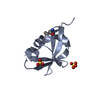
| ||||||||
| 2 | 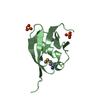
| ||||||||
| Unit cell |
| ||||||||
| Details | CRYSTAL PACKING ANALYSIS SUGGESTS THE ASSIGNMENT OF A MONOMER AS THE SIGNIFICANT OLIGOMERIZATION STATE. |
- Components
Components
| #1: Protein | Mass: 9958.121 Da / Num. of mol.: 2 Source method: isolated from a genetically manipulated source Source: (gene. exp.)   Homo sapiens (human) / Gene: BAG6, BAT3, BC003133, G3 / Plasmid: SpeedET / Production host: Homo sapiens (human) / Gene: BAG6, BAT3, BC003133, G3 / Plasmid: SpeedET / Production host:   Escherichia Coli (E. coli) / Strain (production host): HK100 / References: UniProt: P46379 Escherichia Coli (E. coli) / Strain (production host): HK100 / References: UniProt: P46379#2: Chemical | ChemComp-SO4 /  Sulfate Sulfate#3: Water | ChemComp-HOH / |  Water WaterSequence details | THIS CONSTRUCT WAS EXPRESSED WITH A PURIFICATION TAG MGSDKIHHHHHHENLYFQG. THE TAG WAS REMOVED WITH ...THIS CONSTRUCT WAS EXPRESSED WITH A PURIFICATI | |
|---|
-Experimental details
-Experiment
| Experiment | Method:  X-RAY DIFFRACTION / Number of used crystals: 1 X-RAY DIFFRACTION / Number of used crystals: 1 |
|---|
- Sample preparation
Sample preparation
| Crystal | Density Matthews: 2.46 Å3/Da / Density % sol: 49.98 % |
|---|---|
Crystal grow | Temperature: 277 K / Method: vapor diffusion, sitting drop / pH: 5.6 Details: 2.0M (NH4)2SO4, 0.2M K/Na Tartrate, 0.1M Citrate pH 5.6, NANODROP, VAPOR DIFFUSION, SITTING DROP, temperature 277K |
-Data collection
| Diffraction | Mean temperature: 100 K | |||||||||||||||||||||||||||||||||||||||||||||||||||||||||||||||||||||||||||||
|---|---|---|---|---|---|---|---|---|---|---|---|---|---|---|---|---|---|---|---|---|---|---|---|---|---|---|---|---|---|---|---|---|---|---|---|---|---|---|---|---|---|---|---|---|---|---|---|---|---|---|---|---|---|---|---|---|---|---|---|---|---|---|---|---|---|---|---|---|---|---|---|---|---|---|---|---|---|---|
| Diffraction source | Source:  SYNCHROTRON / Site: SYNCHROTRON / Site:  SSRL SSRL  / Beamline: BL9-2 / Wavelength: 0.91162, 0.97949, 0.97903 / Beamline: BL9-2 / Wavelength: 0.91162, 0.97949, 0.97903 | |||||||||||||||||||||||||||||||||||||||||||||||||||||||||||||||||||||||||||||
| Detector | Type: MARMOSAIC 325 mm CCD / Detector: CCD / Date: Dec 1, 2011 / Details: double crystal monochromator | |||||||||||||||||||||||||||||||||||||||||||||||||||||||||||||||||||||||||||||
| Radiation | Monochromator: double crystal / Protocol: MAD / Monochromatic (M) / Laue (L): M / Scattering type: x-ray | |||||||||||||||||||||||||||||||||||||||||||||||||||||||||||||||||||||||||||||
| Radiation wavelength |
| |||||||||||||||||||||||||||||||||||||||||||||||||||||||||||||||||||||||||||||
| Reflection | Resolution: 1.8→28.33 Å / Num. obs: 18720 / % possible obs: 97.9 % / Observed criterion σ(I): -3 / Biso Wilson estimate: 26.113 Å2 / Rmerge(I) obs: 0.042 / Net I/σ(I): 10.74 | |||||||||||||||||||||||||||||||||||||||||||||||||||||||||||||||||||||||||||||
| Reflection shell | Diffraction-ID: 1
|
-Phasing
Phasing | Method:  MAD MAD |
|---|
- Processing
Processing
| Software |
| |||||||||||||||||||||||||||||||||||||||||||||||||||||||||||||||||||||||||||
|---|---|---|---|---|---|---|---|---|---|---|---|---|---|---|---|---|---|---|---|---|---|---|---|---|---|---|---|---|---|---|---|---|---|---|---|---|---|---|---|---|---|---|---|---|---|---|---|---|---|---|---|---|---|---|---|---|---|---|---|---|---|---|---|---|---|---|---|---|---|---|---|---|---|---|---|---|
| Refinement | Method to determine structure : :  MAD / Resolution: 1.8→28.33 Å / Cor.coef. Fo:Fc: 0.972 / Cor.coef. Fo:Fc free: 0.946 / Occupancy max: 1 / Occupancy min: 0.4 / SU B: 6.014 / SU ML: 0.094 / Cross valid method: THROUGHOUT / σ(F): 0 / ESU R: 0.118 / ESU R Free: 0.127 MAD / Resolution: 1.8→28.33 Å / Cor.coef. Fo:Fc: 0.972 / Cor.coef. Fo:Fc free: 0.946 / Occupancy max: 1 / Occupancy min: 0.4 / SU B: 6.014 / SU ML: 0.094 / Cross valid method: THROUGHOUT / σ(F): 0 / ESU R: 0.118 / ESU R Free: 0.127 Stereochemistry target values: MAXIMUM LIKELIHOOD WITH PHASES Details: 1. HYDROGENS HAVE BEEN ADDED IN THE RIDING POSITIONS. 2. ATOM RECORD CONTAINS SUM OF TLS AND RESIDUAL B FACTORS. 3. ANISOU RECORD CONTAINS SUM OF TLS AND RESIDUAL U FACTORS. 4. WATERS WERE ...Details: 1. HYDROGENS HAVE BEEN ADDED IN THE RIDING POSITIONS. 2. ATOM RECORD CONTAINS SUM OF TLS AND RESIDUAL B FACTORS. 3. ANISOU RECORD CONTAINS SUM OF TLS AND RESIDUAL U FACTORS. 4. WATERS WERE EXCLUDED FROM AUTOMATIC TLS ASSIGNMENT. 5. A MET-INHIBITION PROTOCOL WAS USED FOR SELENOMETHIONINE INCORPORATION DURING PROTEIN EXPRESSION. THE OCCUPANCY OF THE SE ATOMS IN THE MSE RESIDUES WAS REDUCED TO 0.75 FOR THE REDUCED SCATTERING POWER DUE TO PARTIAL S-MET INCORPORATION. 6. SULFATE IONS (SO4) FROM THE CRYSTALLIZATION SOLUTION ARE MODELED.
| |||||||||||||||||||||||||||||||||||||||||||||||||||||||||||||||||||||||||||
| Solvent computation | Ion probe radii: 0.8 Å / Shrinkage radii: 0.8 Å / VDW probe radii: 1.2 Å / Solvent model: BABINET MODEL WITH MASK | |||||||||||||||||||||||||||||||||||||||||||||||||||||||||||||||||||||||||||
| Displacement parameters | Biso max: 99 Å2 / Biso mean: 37.9515 Å2 / Biso min: 21.75 Å2
| |||||||||||||||||||||||||||||||||||||||||||||||||||||||||||||||||||||||||||
| Refinement step | Cycle: LAST / Resolution: 1.8→28.33 Å
| |||||||||||||||||||||||||||||||||||||||||||||||||||||||||||||||||||||||||||
| Refine LS restraints |
| |||||||||||||||||||||||||||||||||||||||||||||||||||||||||||||||||||||||||||
| LS refinement shell | Resolution: 1.8→1.847 Å / Total num. of bins used: 20
| |||||||||||||||||||||||||||||||||||||||||||||||||||||||||||||||||||||||||||
| Refinement TLS params. | Method: refined / Refine-ID: X-RAY DIFFRACTION
| |||||||||||||||||||||||||||||||||||||||||||||||||||||||||||||||||||||||||||
| Refinement TLS group |
|
 Movie
Movie Controller
Controller


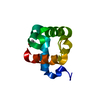
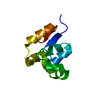
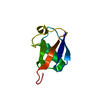

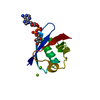
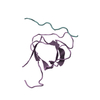

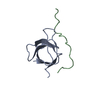
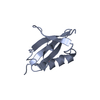
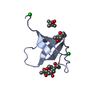
 PDBj
PDBj





